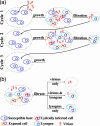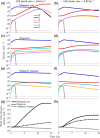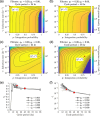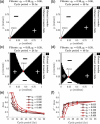Eco-evolutionary dynamics of temperate phages in periodic environments
- PMID: 40421433
- PMCID: PMC12105577
- DOI: 10.1093/ve/veaf019
Eco-evolutionary dynamics of temperate phages in periodic environments
Abstract
Bacteriophages (viruses that exclusively infect bacteria) exhibit a continuum of infection mechanisms, including lysis and lysogeny in interactions with bacterial hosts. Recent work has demonstrated the short-term advantages of lysogeny over lysis in conditions of low host availability. Hence, temperate phage which can switch between lytic and lysogenic strategies-both stochastically and responsively-are hypothesized to have an evolutionary advantage in a broad range of conditions. However, the long-term advantages of lysogeny are not well understood, particularly when environmental conditions vary over time. To examine generalized drivers of viral strategies over the short- and long-term, we explore the eco-evolutionary dynamics of temperate viruses in periodic environments with varying levels of host availability and viral mortality. We use a nonlinear system of ordinary differential equations to simulate periodically-forced dynamics that separate a 'within-growth' phase and a 'between-growth' phase, in which a (potentially unequal) fraction of virus particles and lysogens survive. Using this ecological model and invasion analysis, we show and quantify how conflicts can arise between strategies in the short term that may favour lysis and strategies in the long term that may favour lysogeny. In doing so, we identify a wide range of conditions in which temperate strategies can outperform obligately lytic or lysogenic strategies. Finally, we demonstrate that temperate strategies can mitigate against the potential local extinction of viruses in stochastically fluctuating environments, providing further evidence of the eco-evolutionary benefits of being temperate.
© The Author(s) 2025. Published by Oxford University Press.
Conflict of interest statement
None declared.
Figures






References
-
- Abedon ST. Bacteriophages as Drivers of Evolution: An Evolutionary Ecological Perspective. Springer International Publishing, 2022. 10.1007/978-3-030-94309-7 - DOI
LinkOut - more resources
Full Text Sources

